|
|
Post by flycookie on Jan 6, 2008 12:09:17 GMT 12
Look at the words painted along the island..........
|
|
|
|
Post by FlyNavy on Jan 6, 2008 12:37:31 GMT 12
For my tired eyes I have to 'zoom' the browser IE7 to even have a chance to read "Beware of rotors and jet blast" on my screen. And so they should be beware... ;D English is the language of aviation, NO? I guess the French try to differ but we ignore them resolutely.
|
|
|
|
Post by flycookie on Jan 8, 2008 16:11:47 GMT 12
FlyNavy, this appeared in my work (some people never learn) email today. I think it rathers adds to your possible explanation:
> > A U.S. Navy Admiral was attending a naval conference
> > that included Admirals from the U.S., British, Canadian,
> > Australian, New Zealand and French navies. At a cocktail reception, he
> > found himself standing with a large group of Officers that
> > included personnel from most of those countries. Everyone was
> > chatting away in English as they sipped their drinks but a
> > French admiral suddenly complained that, 'whereas Europeans
> > learn many languages, Americans learn only English.' He then
> > asked, 'Why is it that we always have to speak English in
> > these conferences rather than speaking French?'
> >
> > Without hesitating, the American Admiral replied 'Maybe
> > it's because the Brits, Canadians, Aussies, Kiwis and Americans
> > arranged it so you wouldn't have to speak German.'
> >
> > You could have heard a pin drop
|
|
|
|
Post by FlyNavy on Jan 8, 2008 17:05:41 GMT 12
;D
|
|
|
|
Post by flycookie on Jan 14, 2008 16:07:11 GMT 12
www.qinetiq.com/home/newsroom/news_releases_homepage/2007/2nd_quarter/vaac_de_gaulle.html QinetiQ conducts rolling Harrier landing trials on French carrier 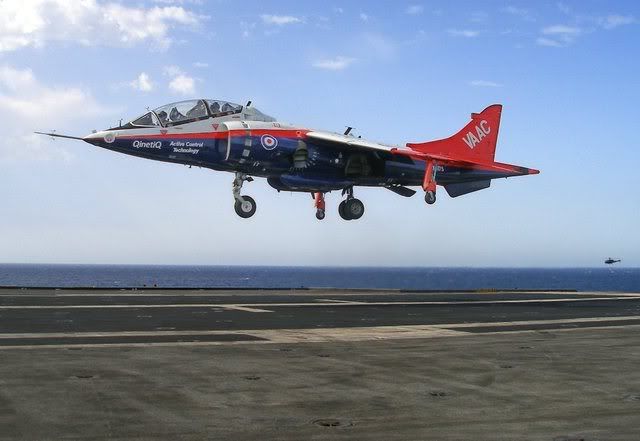 Not rolling in this pic - the nozzles are down. QinetiQ's VAAC Harrier undertakes payload boosting landing trials on the French carrier Charles de Gaulle as part of a Joint Strike Fighter (JSF)-programme QinetiQ and the MOD Joint Test and Evaluation Group, which comprise the UK Aircraft Test and Evaluation Centre, are currently undertaking a series of landing trials of a short take-off vertical landing (STOVL) aircraft on to the French Navy's Charles de Gaulle carrier, using QinetiQ's Vectored-thrust Aircraft Advanced Control (VAAC) experimental Harrier. Undertaken as part of the US Joint Strike Fighter (JSF) programme on behalf of the UK MOD Joint Combat Aircraft Integrated Project Team (JCA IPT), the trials were designed to expand the limits and knowledge of ship rolling vertical landings (SRVL) as a possible aircraft recovery technique for the Royal Navy's two projected Future Carrier (CVF) vessels. Land based Rolling Vertical Landings (RVL) are routinely used on legacy STOVL (Harrier) aircraft, rather than vertical landings on unprepared surfaces, in order to avoid ingestion of debris into the engine. A requirement for JSF to perform land based RVLs has therefore always been a feature of the contract specification. However, the development of new RVL procedures for the F-35B aircraft, with its greater useable wing-lift at low speeds, means that either increased payloads can be returned and landed on the ship or the stress on the propulsion system can be reduced, leading to increased operational flexibility and propulsion system life. The MOD has stated: "Consideration of the aerodynamic performance of JSF, together with the available deck area of CVF design, has shown that significant benefits could be realised by extending the principles of land based RVL to ship borne operations and the UK is keen to exploit this opportunity." This series of trials involves the first ever piloted evaluation of the SRVL manoeuvre onto an aircraft carrier, and comes on the back of a number of studies undertaken over the past few years into the feasibility of the SRVL concept. The MOD has also stated that the increasing maturity of this body of analysis and simulation indicates that SRVL could be performed safely by JSF on CVF although the effects of equipment failures and adverse conditions require further investigation. Work into this will continue to be undertaken by QinetiQ at the MOD's Boscombe Down site and using VAAC simulators at its Bedford site. "The Charles de Gaulle carrier, at around 40,000 tonnes has a similar deck size to the projected CVF vessels so made it the ideal choice for this series of trials", stated Richard Watson, QinetiQ's VAAC programme Manager. "As the French are likely to play a key part in the development and fabrication stages of the CVF programme it was also logical and beneficial to include them at this stage. The French team members in this trial have provided outstanding support in a challenging programme, and have been incredibly generous with their time, energy and overall contribution to the success of these test flights." In 2005 a world first was also achieved when a fully automatic landing of the QinetiQ VAAC Harrier was conducted on HMS Invincible. QinetiQ's team of engineers with Royal Navy and Royal Air Force test pilots successfully demonstrated that the technology it has developed as part of its work for the Joint Strike Fighter programme could automatically bring a STOVL aircraft into land. This clearly demonstrated how exploiting advanced technology can reduce programme risk and bring real benefits for the pilots. QinetiQ is also conducting ongoing work in maturing flight control concepts for the F-35B Lightning 2 and the Aircraft Test and Evaluation Centre recently completed an evaluation of advanced STOVL flight control concepts in collaboration with the JSF Program Office and test pilots from the JSF programme. This ongoing work follows the pioneering development of Unified Flight Control, a novel STOVL control concept which was adopted for the F-35B in 2002. Unified Flight Control enables the pilot to simply command the aircraft to go faster or slower and up or down whilst the fly-by-wire control system does all the hard work. QinetiQ's autoland technology took this capability a step further and the autoland technology also opened up the door for operating Unmanned Air Vehicles (UAVs) from ships 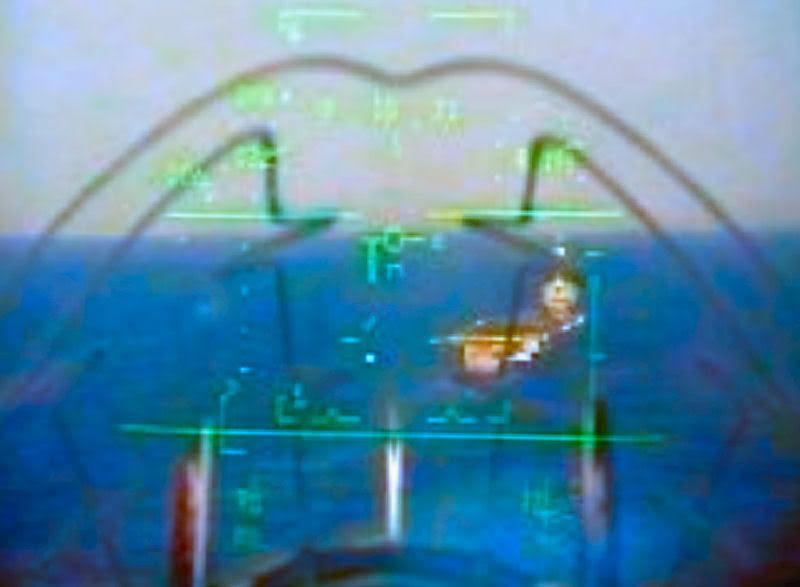 Charles de Gaulle from the VAAC Harrier's front seat (pic enlarged from thumbnail).
|
|
|
|
Post by FlyNavy on Jan 14, 2008 18:16:59 GMT 12
Perhaps in that last photo we see the rear seat view? I guess the photographer / passenger would be there. We see the explosive canopy breaking cord (for front seat) with a canopy bow at bottom of view? Great view for the rear seater. I gather this would be essential for Harrier training? For any training it is a great view forward.
|
|
|
|
Post by flycookie on Jan 24, 2008 16:27:22 GMT 12
www.ft.com/cms/s/0/227eba38-c7ad-11dc-a0b4-0000779fd2ac.html?nclick_check=1MoD offered £100m saving on carriers By Sylvia Pfeifer, Defence Industries Correspondent Published: January 21 2008 00:58 | Last updated: January 21 2008 00:58 The companies building two aircraft carriers for the Royal Navy have proposed a cost-cutting plan to keep the programme on track. BAE Systems and VT Group, two of the largest companies in the alliance building the carriers, have offered a scheme that will defer £100m ($195m) of government spending over two years. The £4bn programme is under pressure because of budget constraints at the Ministry of Defence. The move follows an informal request from the MoD to industry this month to find ways to slow spending on the carriers. The MoD is believed to be looking for overall savings of some £200m on the programme over the next two years. The department is facing an estimated budget shortfall of as much as £2bn over the next two to three years and is desperately looking for ways to make cost savings on most of its large equipment programmes. Defence analysts said that by delaying activities, such as the procurement of equipment or deferring payment to suppliers, the companies could make savings. Partners in the alliance, which also includes Babcock International and Thales UK, are keen to sign a manufacturing contract with the MoD as soon as possible. The carriers are due to enter service in 2014 and 2016. It is not known whether the MoD believes the proposal is enough to save the programme from a delay. Sources close to the talks stressed that negotiations on the carriers were just one of a number of things the MoD was looking at to cut costs. There is no suggestion that the programme will not go ahead. But a delay would throw into doubt plans for a joint venture between BAE and VT to create a national champion. Such a partnership was seen as the first step towards the consolidation of the shipbuilding industry. The two companies had agreed an alliance last summer and had hoped to finalise terms earlier this month. But final sign-off is contingent on a terms of business agreement with the government. The agreement would offer industry an unprecedented guarantee to maintain jobs and technical capabilities for 15 years. The carriers are seen as the cornerstone of that work. The MoD has agreed to support the new venture with sufficient orders to maintain Britain's naval shipbuilding capacity. If orders do not come, the MoD has agreed to underwrite the costs of keeping certain technical capabilities alive. Copyright The Financial Times Limited 2008 "FT" and "Financial Times" are trademarks of the Financial Times. Privacy policy | Terms (c) Copyright The Financial Times Ltd 2008.
|
|
|
|
Post by flycookie on Jan 30, 2008 16:44:44 GMT 12
FlyCookie: This from the Financial Times. While I can understand frustration with the situation, I don't see what the big deal is. The STOVL F-35s have been long slated to be last off the production line, and with the usual delays in such a big new system, there was no way they were going to enter service at about the same time as the ships. 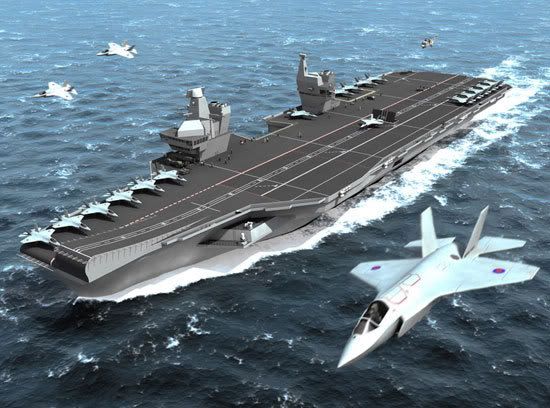 www.ft.com/cms/s/0/a0975762-cec0-11dc-877a-000077b07658.html www.ft.com/cms/s/0/a0975762-cec0-11dc-877a-000077b07658.htmlNavy’s new carriers to deploy old aircraft By Sylvia Pfeifer, Defence Industries Correspondent Published: January 30 2008 01:53 | Last updated: January 30 2008 01:53 The most powerful ships ever to sail in the Royal Navy will be forced to fly ageing Harrier jets because the replacement F35 Joint Strike Fighters (JSFs) will not be ready in time. The first of two new aircraft carriers is due to enter service in 2014 and the government had planned to operate Britain’s next generation combat plane, the JSF, from the ships. However, it emerged on Tuesday that the Navy will instead initially have to operate the latest version of the Harrier jump jet, an aircraft first designed several decades ago. Giving evidence to the Commons’ defence select committee, David Gould, the MoD chief operating officer for equipment and support, said: “We actually do plan to use the [Harrier] GR9 on the first of the carriers. The idea that we will have a carrier’s worth of fully ... equipped JSFs in 2014 is not going to happen.” The $276bn (£140bn) JSF programme is the most expensive armaments programme ever and Britain is the biggest partner to the US. The UK had originally intended to acquire 150 JSFs but at Tuesday’s hearing General Sir Kevin O’Donoghue, the chief of defence material, admitted that the eventual number would depend on the final price – which has yet to be decided. Francis Tusa, editor of Defence Analysis, said: “They are admitting there is no cost control from this end of the pond. There is a slight degree of unreality here. JSF costs are going up something like 4 per cent a year. By the time we start laying out money for production, the aircraft will be 30 per cent more expensive than we first budgeted.” General O’Donoghue also acknowledged that there were likely to be cutbacks or delays to major equipment procurement programmes. “I suspect we will have to [delay or cut some],” he said. Asked when spending was last so tight, he said: “In the late 1970s, we had some challenging times then.” Separately, Mr Gould identified the Nimrod coastal surveillance aircraft programme as the one where the department is seeing the greatest “cost growth”. The reasons for the continuing cost overruns were due to a problem with pitch on the aircraft, only discovered during the flight trials. It emerged, however, that a similar problem was first identified on an earlier version of aircraft. Responding to a question on why the government had not yet signed a manufacturing contract with the industry alliance building the two aircraft carriers, Mr Gould said he would be disappointed if a contract had not been signed before the end of March. “The fact that we are going through a review of the [defence procurement] programme of the nature we talked about early on ... it is as serious as you have known it in recent years, yes ... that is not an atmosphere when it is easy to take decisions on big commitments,” he said. Copyright The Financial Times Limited 2008.
|
|
|
|
Post by flycookie on Feb 6, 2008 15:31:08 GMT 12
FlyCookie: The poms will do anything to make and keep their beer warm. When the Lusty's undweray in the tropics and heading for Oz they'll have plenty hot beer. Hmm, yum, hot beer. www.abc.net.au/news/stories/2008/01/24/2145792.htmFaulty fridge sends British warship back to base Posted Thu Jan 24, 2008 2:21pm AEDT One of Britain's biggest warships has been forced to retreat back to base by fears about a fridge. The aircraft carrier HMS Illustrious sailed from Portsmouth on the southern English coast, the home of the fleet, to join multi-national operations in the Indian Ocean. But "Lusty" had to turn back because a refrigeration unit used to store meat was in danger of breaking down. "The sensible thing is for her to come in and get that fixed before she goes off again," said Royal Navy spokesman Anton Hanney. "It wouldn't be prudent for her to go off with the chance of the unit breaking down while she was in warmer climates and then engineers would have to be flown out to her to fix it." The warship - scheduled for replacement in 2012 - is set to lead the Orion 08 multi-national task group, which will be carrying out exercises during the next four months in the Indian Ocean. The group is to visit 20 ports in the Mediterranean, Africa, the Middle East, South Asia and the Far East. Officials say HMS Illustrious - 209 metres long with a displacement of 22,000 tonnes and carrying Sea Harrier jump-jet fighters - is likely to return to sea on Thursday (local time). - AFP FlyCookie again: That bit about embarked Sea Harriers is bollocks. I think the reporter must not have seen this pic, taken in 2006. At Yeovs, obviously. 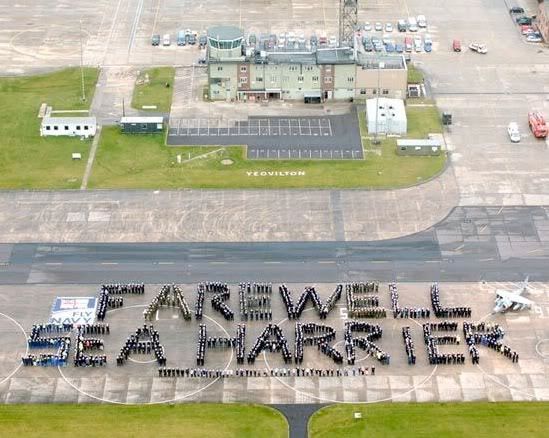
|
|
|
|
Post by flycookie on Feb 8, 2008 16:42:46 GMT 12
The following quote is the final paragraph of Sharkey's piece in the current warships IFR. The previous 950 words might have been nonsensical and drivel, but at least they never strayed from 'ranting.' This is goes to another level, one indicative of 'raving.' As I say, sad. +++The man credited with establishing the Royal Air Force, Lord Trenchard, said that there would come a time when the RAF would have to be subsumed by the Army and the Royal Navy. Clearly, and in the light of the two main threats facing our national military capability, that time has now come.+++ Lest anyone depart this thread worried about matters worringly neurological, here's a totally groovy vid clip of Sea Harriers.  |
|
|
|
Post by FlyNavy on Feb 8, 2008 16:56:48 GMT 12
QUOTE from previous page Financial Times story: "The reasons for the continuing cost overruns were due to a problem with pitch on the aircraft, only discovered during the flight trials." No wonder Sharkey wants to join the 'Monster Loony Raving Party' (formerly legitimate political party in UK chaired by Screaming Lord Sutch - now dead if I remember all this correctly). I guess I need to look that up in me Funk and Wagnall. I digress... [http://www.omrlp.com/]
If I 'discovered pitch' on my aircraft I would want to know 'what bleeding pterodactyl had dun it'. Not "Which pterodactyl" because they might trouble me otherwise. ;D [Some may know I have stolen this joke. Proper joke/story on request.]
FryCookie: What do you have against Sharkey? He is a proper fighter for the RN against all fings RAF.
|
|
|
|
Post by FlyNavy on Feb 8, 2008 23:30:09 GMT 12
OK OK I got no takers so I thought that I had better explain at least one thing..... "The pitch on the aircraft" (WOT?) is in this joke something akin to another kind of 'pitch' - how about that black stuff which droppeth from a terrordactil? NO? OK too obscure. Fair enuf guv. Fly droppings maybe?
What intrigued me about the FinTimes was that a reporter from a Financial Newspaper could say something like a 'problem with pitch on the aircraft' - what the heck does that mean? Hmmmm. ;D And you thought I was obscure.
|
|
|
|
Post by flycookie on Feb 15, 2008 13:58:09 GMT 12
Way cool pic of USMC AV8B plugging and glugging. Maybe they were over sharkey infested waters. 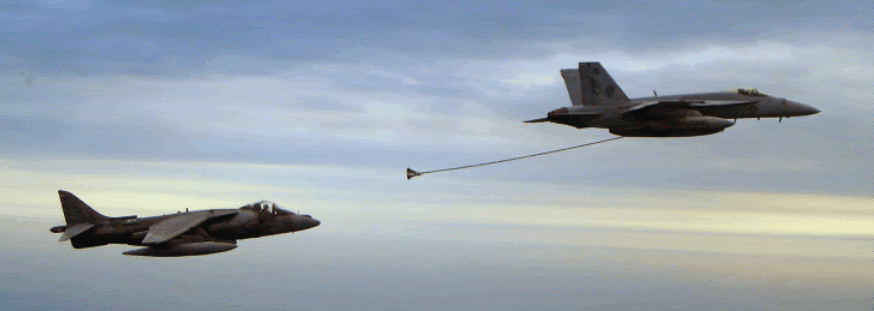 |
|
|
|
Post by flycookie on Feb 17, 2008 16:19:58 GMT 12
FlyCookie: Following news story seems to be the first solid news of something actually HAPPENING on the new Royal Navy STOVL carrier construction front. It's only taken Westminster and Whitehall 10 years. I have now received two off-fourm requests to discuss one or two things in previous entries here. I'm flattered, but unsure I can add anything of value. After a bit of a think, and perhaps a cuppa tea and an Iced VoVo, I'll see if I can rustle up some words. Anyhow, it's back to the Central Commentary Position, with Richie and Tony to take you through the news until today's end of play on the new carrier front. news.scotsman.com/scotland/Dockyard39s-ship-comes-in-.3763883.jpPublished Date: 11 February 2008 Source: Edinburgh Evening News Location: Scotland Dockyard's ship comes in as £50m cash deal is sealedBy CHRIS MARSHALL ROSYTH dockyard is set for a massive jobs boost after a £50 million investment package was today unveiled to prepare the yard for assembling two Royal Navy aircraft carriers. Defence Secretary Des Browne witnessed the signing of a £35m contract between Babcock Marine and the Scottish arm of construction firm Edmund Nuttall, which will make up the majority of the investment. Key equipment, such as the Goliath crane, the largest in the UK, will now be purchased to make sure the docks are ready for the massive project. Mr Browne said: "This is a significant investment in shipbuilding in Rosyth and a symbol of our commitment to the two new aircraft carriers, which will be the largest ships ever sailed by the Royal Navy. I'm delighted to see this boost for the maritime industry in Scotland and jobs for Scottish workers." The project is also set to provide work for local firms, who will be used for contract work, plant hire and materials. The decision to build the carriers was announced by the Government four years ago, but the final contracts have been delayed because BAE Systems and VT, the companies that will build the two 660,000 tonne ships, had not set up a legal entity to do the work. The aircraft carriers are to be constructed in sections in shipyards at Portsmouth, Barrow-in-Furness, Glasgow and Rosyth, with final assembly at Rosyth. Martin Rogers, chief executive of Edmund Nuttall Limited, which employs 250 people in Scotland, said: "We are delighted to have secured this major package of work, extending a long-standing and successful relationship between Nuttall and Babcock at Rosyth." Recent reports had suggested there might be delays in the £3.9 billion project to assemble the supercarriers at Rosyth. Babcock chief executive Peter Rogers said: "The award of this contract is the culmination of a great deal of hard work by the Babcock Marine team and Edmund Nuttall, together with our colleagues in the Aircraft Carrier Alliance – including the Ministry of Defence – to ensure the Rosyth site is ready to play its part in what is the most exciting and largest defence project for many years." Last month, Prime Minister Gordon Brown was forced to issue assurances that the project was still going ahead. Dunfermline and West Fife MP Willie Rennie asked why the contracts for the job had still not been signed, even though the Defence Secretary announced the go-ahead last July. Dockyard and union chiefs had raised fears that any delays would result in job losses. Babcock Marine boss Archie Bethel said in November that the business would add 350 highly-skilled jobs as it geared up for the aircraft carrier project. Babcock Marine, which employs around 8000 people – more than 1000 of them working at Rosyth – is the largest business of its kind in the UK and has a turnover of around £750m.
|
|
|
|
Post by FlyNavy on Feb 17, 2008 16:43:09 GMT 12
Yeah but, NO but, yeah but... NO actual contract signed for ship/carrier building as yet we are told. Or am I wrong on that? AND it seems it is not the guvmnts fault: "but the final contracts have been delayed because BAE Systems and VT, the companies that will build the two 660,000 tonne ships, had not set up a legal entity to do the work."
|
|
|
|
Post by flycookie on Feb 17, 2008 16:54:18 GMT 12
Good pragmatism there, FlyNavy.
Maybe some of the reporters, commentators and I have foolishly discarded scepticism for all of "Bottler" Brown's byzantine ideas of what constitutes a promise for something more optimistic.
Although, maybe the GRT of the ships has something to do with the delay in concluding the offers and acceptances of the contract.
After all, a carrier displacing "660,000 tonnes" would be one for both Ripley's and Guinness. Ay carumba!
|
|
|
|
Post by FlyNavy on Feb 17, 2008 17:23:19 GMT 12
"660,000 tonnes"? Missed it by that much. Formidable ships if ever built at 65K tonnes with aircraft and the usual hangars on. I guess anything goes nowadays for any old tosh on the internet news. Readers can proofread for themselves and read between the lines. Hey do we need misreporters in the first instance? I dunno. Yes but no but yeah but no...
|
|
|
|
Post by flycookie on Feb 19, 2008 13:25:52 GMT 12
FlyCookie: Following quote is an excerpt from a Financial Times story which, more or less, repeats the above story about the new dock works. Only posting it because a great howler somehow got through the editing process. It's comforting to know that even the FT makes quality boo-boos! See if you can spot it. Also a refreshingly honest quote about the delays on the money front. Grrrr! www.ft.com/cms/s/0/bf2c9bd0-d82d-11dc-98f7-0000779fd2ac.htmlBrowne to back upgrade of Rosyth dockyard+++The two carriers – the Queen Elizabeth and the Prince Charles – are due to enter service in 2012 and 2014. But industry is still waiting for the award of the manufacturing contract from the MoD, which had originally been expected in the middle of last month. One industry executive said: "The MoD is being very honest about the situation. They are saying, 'Give us some time, we have a budget problem.' +++ The second carrier is to be HMS Prince of Wales, not, erm, Chuck.
|
|
|
|
Post by yak2 on Feb 19, 2008 13:41:46 GMT 12
"660,000 tonnes"? about the size of Christmas Island.......a handy little unsinkable 'aircraft carrier' anchored just off the coast of one of our neighbours.
|
|
|
|
Post by FlyNavy on Feb 19, 2008 13:42:51 GMT 12
I guess the new Brit carriers will be nicknamed "Mum" and "Chaz"? ['Mother' is reserved for an aircraft's 'mutha' ship.]
|
|